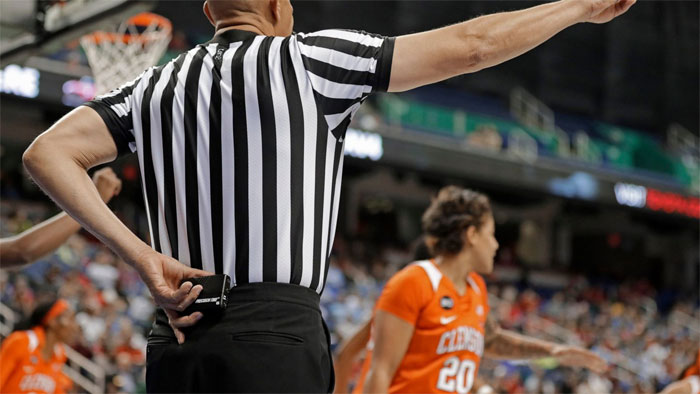It is one of the most commonly called violations in the NBA. In fact, it's so common because four different fouls go by the same name.
So, what is the 5-second rule? Let’s take a look at what warrants a 5-second violation and the penalties associated.
When attacking, this violation gives your opponents an advantage because you lose possession of the ball each time. On the other hand, as a defender, the 5-second rule can result in you winning a free throw-in.
Therefore, the five-second rule is an advantage if used well. However, it may cost your team points if you don't watch out for it.
The 5 Second Rule: Beginner's Guide
The 5-second rule in basketball refers to four different types of fouls committed when an attacking player has the ball for five consecutive seconds without making a move.
This rule prevents the attacking team from holding onto the ball and stalling or delaying the gameplay. Otherwise, the offensive player could hold onto the ball and not move for minutes.
On the other hand, the 5-second rule gives skilled defenders the chance to win possession away from the other team. During this time, the referee starts the five-second count by extending their arm and retracting it.

Next, the referee stretches out his arm for each second and brings it back repeatedly. After counting five times (one for each second), the referee blows the whistle, and the game is called dead.
Next, the referee raises his five fingers and points to the side of the court (the defending side), which should receive a free throw-in. Finally, the defending side takes the ball.
However, the referee must signify when the count starts by extending their arm fully and retracting it. If the attacking player moves, the count stops. Then, the referee switches arms and resumes the count with the other hand.
Types of 5-Second Rules
As basketball gameplay developed, variations on the 5-second rule have occurred over the years. Today, there are four types of 5-second rules in basketball.
5-Second Inbounding Rule
When most people talk about the 5-second rule, they refer to this variation. This rule prevents a player from holding onto the ball without inbounding it for more than five seconds. A player can foul this rule at any stage of the game.
When a player receives the ball from the referee at any point in the court, the count starts. If they do not inbound the ball for more than five seconds, the player has committed a foul, and the referee declares the game dead.
This variation of the five-second rule fouls is the easiest to spot.
5-Second Back to the Basket Rule
This rule applies to NBA basketball only. At the extended free throw line on the court, the attacking player cannot dribble continuously with the goal basket behind their back or side for over five seconds.
Funny enough, this rule came from the NBA Legend Charles Barkley's way of scoring through a tight defense. Therefore, people also call it the Charles Barkley rule. Barkley would push defenders with his back while dribbling until scoring became possible.
To avoid violating this rule, you must turn your face to the basket, shoot or pass the ball.
5-Second Closely Guarded Rule
According to basketball rules, when an attacking player is within six feet of a defender, they are closely guarded. The 5-second rule states that an attacker cannot hold the ball for more than five seconds without passing, shooting, or dribbling when closely guarded.
Lots of basketball players, even professionals, commit this very common foul. Therefore, watch out.
The 5-second, closely guarded rule is easy to foul when defenders trap attacking players. It becomes less frequent as the game heats up and more dribbles, passes, and shots occur.
5-Second Free Throw Rule
Like the 5-second inbound rule, this rule prevents players from stalling the game. The 5-second free throw rule states when a player holds onto the ball from a free throw for more than five seconds without playing it, they have committed a foul.
After receiving it from the referee, every player has five seconds to shoot the free throw ball at the basket. If the player does not make a move, the ball switches possession.

If another player from the same team gets a free throw, the referee restarts the counting.
Penalties for the 5 Second Rule
The penalties associated with each variation of the 5-second rule are the same.
The referee blows the whistle and calls the ball dead. Then, the opponent (defending players) takes possession of the ball.
How to Avoid 5-Second Rule Violations as an Attacker
Make sure you do not hold onto the ball for longer than necessary without dribbling or passing.
When the referee begins the countdown, do not wait till the last moment. Dribble your way through or pass the ball if necessary.
Be wary of any defenders, as they may get you in a trap so that you foul the 5-second rule.
How to Draw a 5-Second Foul as a Defender
Try to get the attacking player within six feet from you and mark every movement he makes. This way, you are closely guarding him, and the 5-second rule applies.
If an attacker tries breaking through the free-throw line with their back, engage them in that position without exposing the basket. This way, you keep them long enough to make them foul.
Summing Up
Understanding the 5-second rule of basketball is very important.
The free throw-ins when a player fouls the 5-second rule make many teams win or lose matches every year.
You can easily trigger it and turn outcomes to favor your team as a defender. In addition, you rack up some extra points for your team.
Also, as an attacker, you'd want to watch out for it and make sure you do not give your opponents the advantage of a free throw-in.
